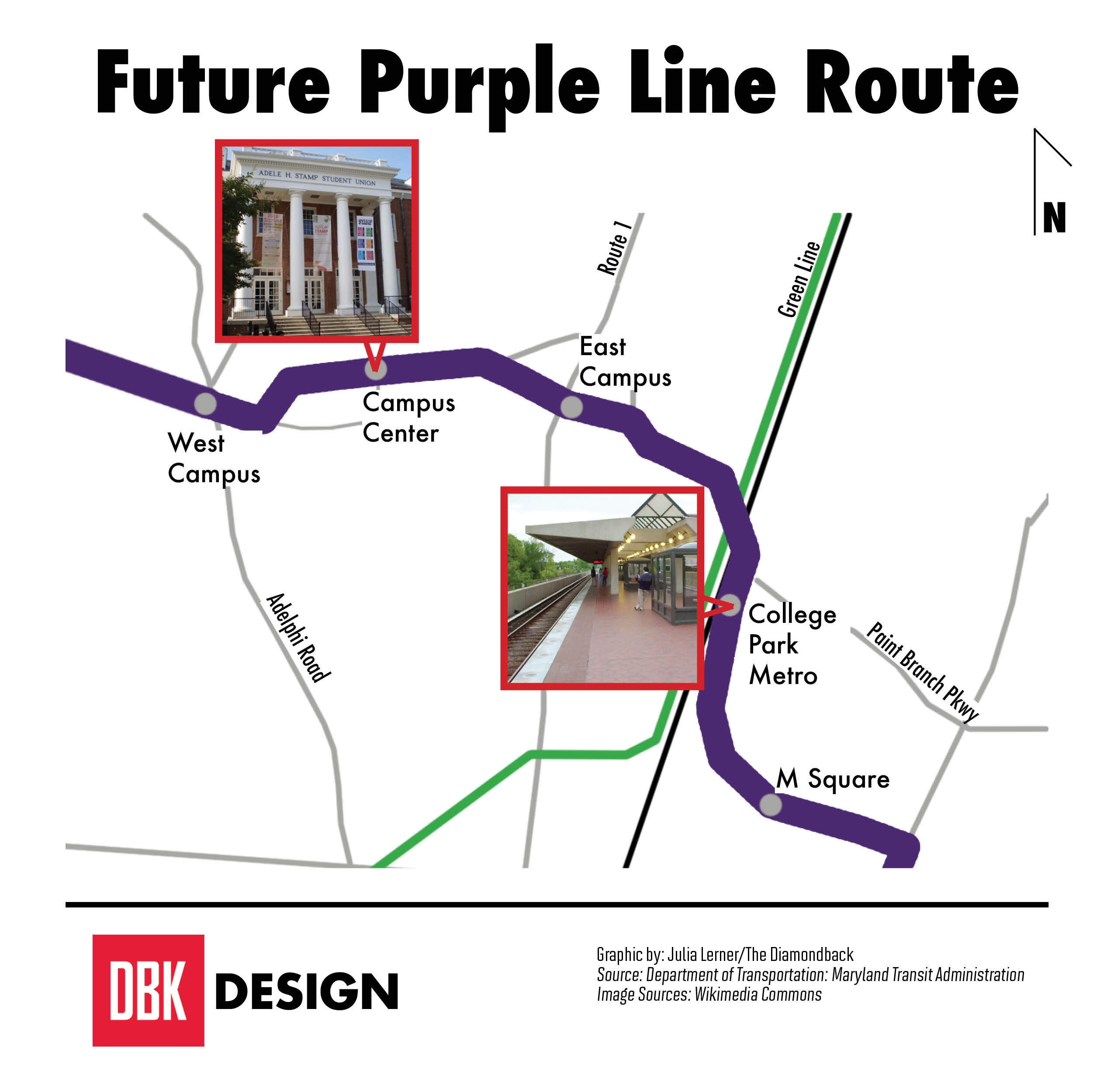Construction for the Purple Line will begin on the University of Maryland campus late this summer, according to university administration and finance vice president Carlo Colella.
The construction for the above-ground line will take two or three years, Colella said. Riding the five Purple Line stations closest to the campus will be free for university students, faculty and staff, in what he described as a “fare-free zone.”
“Getting across campus is going to change in a positive way, for the university community to be able to hop on and hop off,” Colella said.
[Read more: Maryland will receive full federal funding for Purple Line]
Purple Line construction will result in temporary road closures and traffic detours, Colella said. Majorly disruptive work of this nature is scheduled for the summer and winter months when there is less on-campus activity, he said, but work will continue on the campus through the academic semester.
Purple Line Public Affairs Manager Rebecca Romine wrote in a statement that the day shift work hours for the construction will be 7 a.m. to 5 p.m. Monday through Friday but will be adjusted as needed during school sessions. Night shift work will occur 8 p.m. to 4:30 a.m. Monday through Friday when required, she wrote.
Lane closures will happen between 9 a.m. and 3 p.m. Monday through Friday, Romine wrote, and will be coordinated with University Police.
“One of our main objectives throughout is to minimize the impact of construction to our operations,” Colella said.
[Read more: Officials unveil a sidewalk connecting College Park and Riverdale Park]
Lot 1 will lose hundreds of spaces in the upcoming semesters due to Purple Line construction, Department of Transportation Services spokeswoman Cara Fleck said.
DOTS is working on a relocation plan for permit holders affected by this, she said. The lot will lose more than 250 parking spots in the fall as a result of Purple Line and Cole Field House construction, and 95 more in the spring. Those lost spots will be replaced by 307 parking spaces in Stadium Drive Garage and Terrapin Trail Garage, which used to be allotted to campus visitors, not permit holders.
The five stations in the fare-free zone will include two on the campus near Cole Field House and Baltimore Avenue and three by University of Maryland University College, the College Park Metro Station and in the Discovery District, Romine wrote, and the stops will connect all of the campus.
Fleck said it was too early to say how parking lots other than Lot 1 or any Shuttle-UM routes will be affected by the Purple Line. Colella said more specific information about the construction will be made available as it gets closer.
After the physical work — which includes the relocation of area utilities, demolition of foliage and installation of tracks and power systems — is done on the campus and elsewhere, a long testing phase of cars lacking passengers will need to occur before the line is made operational in 2022, Colella said.
“Construction will be conducted in a phased approach, starting with utility relocation, next storm drainage installation, and rebuild of roads which include setting tracks,” Romine wrote.
Part of the construction will involve “a complete rebuild of Campus Drive,” Romine wrote. Light rail tracks will be installed on the road where buses and cars share the same lanes, and a new bike path that runs parallel to the light rail from Presidential Drive to Route 1 will also be installed, she wrote. Colella said Rossborough Lane will also connect to Campus Drive as part of the project.
“It seems like a long time away,” Colella said, “but for a project of this size, it’s not far away.”
College Park City-University Partnership Executive Director Eric Olson said the Purple Line will “open up the whole world” to College Park residents. In addition to the Washington Metropolitan Area Transit Authority’s Green, Orange and Red lines, the Purple Line will also connect to to Amtrak and MARC stations, which Olson said will make it easier to travel to major cities along the East Coast such as Boston, Philadelphia and New York City.
Being able to walk to more places in the city will result in increased economic activity, Olson said, especially around the Purple Line stations. The Purple Line is also expected to take 7,000 cars off the road in the College Park area alone, said Olson.
The need to drive to and park at this university will also be reduced by the Purple Line, Fleck said. She said DOTS has been trying to push sustainable methods of transportation like walking, biking or carpooling and the Purple Line will add one more option for students and faculty.
“When Purple Line comes through,” Fleck said, “you can just be dropped off actually on campus, you won’t even have to take a bus to get here, which is pretty cool.”



